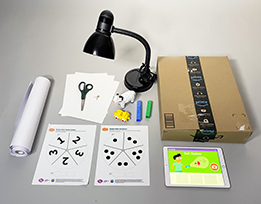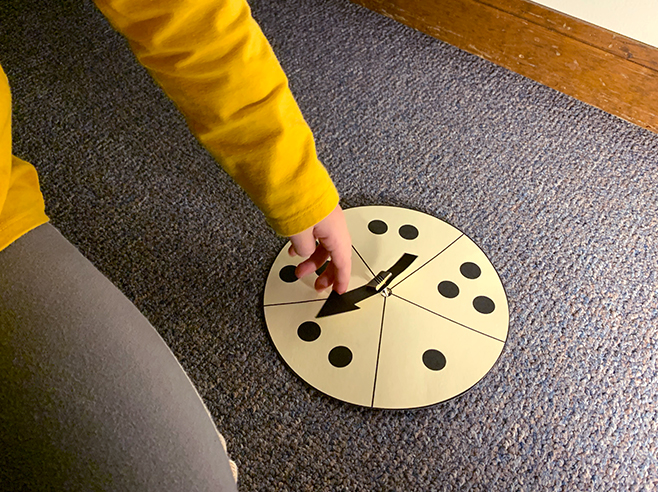Children play shadow math spinner games as they count dots and position objects to build corresponding shadows.
Materials

- Brad fastener or pencil with a point
- Cardboard box (to use as shadow stage)
- Cardstock paper
- LED flashlight or lamp with an adjustable head
- Scissors
- Shadow Math Dot Spinner (PDF) or Shadow Math Number Spinner (PDF)
- Large sheet of chart paper for the shadow surface
- Small objects (such as animal counters, connector cubes, toy animals)
- Table (or other surface for the placing shadow stage and objects)
- Cool Shadows camera tool in the Shadows Journal app
- Optional: number cube or die (as an alternative to the spinner)
Preparation
- Make a copy of the Shadow Math Dot Spinner (or Number spinner) onto cardstock paper. Cut out the arrow spinner and attach it to the center with a brad fastener or hold the arrow in place using a pencil point. Note: If you or your children experience trouble with the spinner, you may want to substitute a die—a small cube with a different number of dots (one to three) on each side.
- Place the game materials in the shadow area. Tape the chart paper to the wall. Position the stage in place and the light to shine on the surface so the “audience” will be able to see the shadows.
- NOTE: For younger children, you may want to focus the math goal on counting. You can also extend the activity to two sessions to allow more time for children to grasp the science goals and the math goals related to spatial vocabulary.
Directions: Lesson 7
Guided Small Groups
- Show children the game materials. Position the light source to shine on the chart paper. Tell children they will take turns being the player who spins the spinner and makes the shadows, and the audience—the players who count and describe the shadows cast.
- Have the shadow maker spin the spinner and the audience count aloud the dots the spinner lands on.
- The shadow maker counts out the corresponding number of small objects and places them, one at a time, on the stage between the light and the surface.
- The audience counts the shadows out loud as they appear on the shadow surface.
- Have children compare the number of dots on the spinner to the number of shadows cast on the surface.
- How many shadows do you see? How many dots is the spinner pointing to? If children notice shadows change when one object is in front of or behind another object, you might explain that when objects touch or overlap, they create one combined shadow. Say, When that happens, the number of shadows will not match the number of dots.
- Continue the game. Encourage children to make shadows under, over, between or next to one another. Take pictures of children’s shadow games with the Cool Shadows camera tool to review and compare in the Learning Center.
Learning Center
- In the earlier Guided Small Group activity, photos were captured during the Shadow Math game using the Cool Shadows camera tool. In this Learning Center activity, children compare the photos.
- Ask pairs or small groups to describe the shadows in their photos and explain how they were made. Then have them:
- Count the number of shadows in their photo.
- Describe what object(s) is making each shadow.
- Describe the position of objects in the photo.
- Find another photo that has the same number of shadows.


